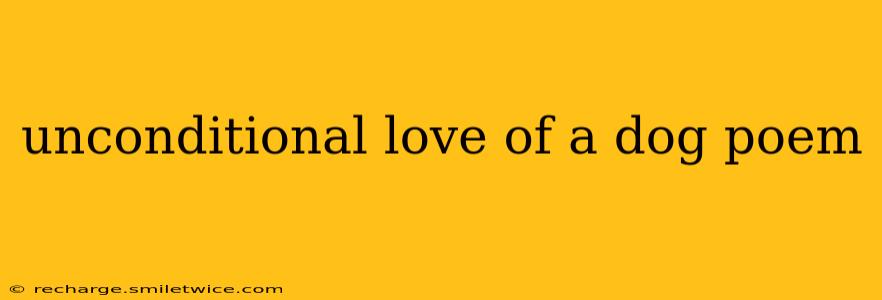The Unconditional Love of a Dog: A Poem and Exploration
The unwavering gaze, a wet nose nudge, a tail thumping a happy rhythm against the floor – these are the hallmarks of a dog's unconditional love, a love so pure and profound it's often described as the purest form of affection a human can experience. This poem explores that special bond, and we'll delve deeper into the science and sentiment behind this unique relationship.
The Poem:
A furry friend, a loyal heart, Through thick and thin, right from the start. No judgment cast, no harsh reprimand, Just wagging tail and helping hand.
A sloppy kiss, a grateful sigh, In soulful eyes, a love so high. Through happy days and sorrows deep, A faithful friend, secrets to keep.
No words are needed, just a glance, A knowing look, a joyful dance. Unconditional, pure, and true, A dog's love shines, forever new.
What makes a dog's love so unconditional?
This question gets to the heart of the matter. Dogs don't love us for our accomplishments, our wealth, or even our good looks. Their affection stems from a deeply ingrained biological and psychological makeup. Years of co-evolution with humans have created a bond where dogs have learned to interpret and respond to human cues, fostering a strong attachment. Oxytocin, the "love hormone," plays a crucial role in this bond, being released in both dogs and humans during interactions, strengthening the connection.
How does a dog show its unconditional love?
The ways a dog expresses love are as diverse as the breeds themselves. However, some common signs include:
- Tail wags: While the intensity and type of wag can vary, a tail wag generally indicates happiness and excitement.
- Eye contact: Sustained eye contact, especially with a relaxed posture, shows trust and affection.
- Licking: Licking is a natural canine behavior, and for many dogs, it's a way to show affection and comfort.
- Following you around: The desire to be near you is a clear sign of attachment and love.
- Bringing you gifts: This could range from a favorite toy to a muddy stick – the intention is to please and share something they value.
Is a dog's love truly unconditional?
While the term "unconditional" emphasizes the unwavering nature of a dog's affection, it's important to acknowledge that even canine love has its limits. Severe neglect, abuse, or consistent negative reinforcement can break down even the strongest bond. However, under typical circumstances, a dog's love is remarkably resilient and forgiving, far surpassing the conditions often found in human relationships. Their ability to offer consistent affection, even after mistakes or difficult times, is a testament to the depth of their loyalty.
Can different breeds show love differently?
Yes, absolutely! Breed temperament and individual personality influence how a dog expresses love. A playful terrier might show affection through enthusiastic games of fetch, while a calm golden retriever might prefer gentle cuddles and quiet companionship. Observing your individual dog's behavior is crucial to understanding its unique way of expressing love. It's not just about the breed; it's about the individual dog.
What are the benefits of having a dog in your life?
The benefits extend far beyond the unconditional love. Studies show that dog ownership can improve physical and mental health, reducing stress, lowering blood pressure, and providing increased opportunities for physical activity and social interaction. The simple act of petting a dog can release endorphins, leading to feelings of well-being. Having a furry companion can combat loneliness and provide a sense of purpose and responsibility.
The unconditional love of a dog is a gift that enriches our lives in countless ways. It's a testament to the powerful bond between humans and animals, a relationship built on trust, loyalty, and an unwavering affection that transcends words.
